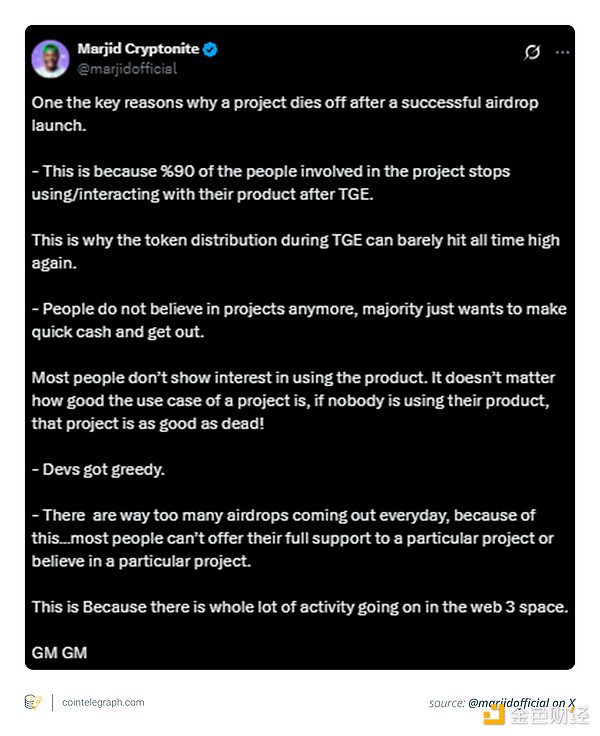Why does blockchain die? What challenges does blockchain adoption face?

Reprinted from jinse
04/15/2025·8DSource: Cointelegraph; Translated by: Deng Tong, Golden Finance
1. Why do some blockchains die
Blockchain may die out due to token economics flaws, fraud, security issues, or insufficient community and development momentum. Even cutting-edge technology can accumulate dust without active participation.
Have you heard of unused blockchains? This situation is much more common than you think. Although the cryptocurrency field is full of innovation, not every blockchain can find its own "tribe". Some blockchains are like ghost towns, with zero transaction volume and few developers, and only a few holders hold worthless tokens. So, what makes blockchain quiet? Can they be reborn?

Not all blockchains last long. Some blockchains, such as Bitcoin, Ethereum and Solana, have survived in a harsh market environment, demonstrating their resilience. However, Terra fell from top to almost forgotten situation in 2022 after its algorithmic stablecoin collapsed.
Even projects with good intentions can fail. Without ongoing development, user incentives, or a strong community, blockchain may become unusable. Once the validator stops running the node, the network will actually become a broken time capsule.
2. Challenges Facing Blockchain Adoption in 2025
Although some blockchains such as Ethereum and Solana are paving the way for blockchain popularity, blockchain popularity in 2025 still faces many obstacles, such as unclear regulation, fragmented development tools, infrastructure gaps, and difficulty in attracting real users rather than robots.
Regulatory uncertainty is one of the biggest obstacles. Governments are still exploring how to regulate cryptocurrencies, and inconsistent or overly strict rules may kill innovation and leave it untouched. Apart from policies, there is no doubt about the booming developer ecosystem. Switching between languages such as Solidity, Rust, and Move-based systems requires flexibility, and not every blockchain can attract the talent needed to grow.
There is also user problem - blockchain is full of robots chasing airdrops, rather than real users participating in technical interactions. Without real user activity, the network's activity indicators are just illusory illusions.
Infrastructure is another major obstacle. A powerful blockchain requires powerful tools, high-quality remote procedure call (RPC) services, and a suite of decentralized validators that ensure uptime and security. In the blockchain field, RPC services are a mechanism that allows applications (such as wallets, DApps, or developer tools) to communicate remotely with blockchain networks.
In addition, the thriving blockchain must embrace a strong community of users, developers and commentators who sincerely believe that blockchain can succeed in the long term.
Reliably dealing with fear, uncertainty, and doubt (FUD) is another test, especially when negative narratives appear; the way blockchain ecosystems respond can make or destroy trust. It is a delicate balance to maintain user loyalty while maintaining freshness.
Ethereum has mastered this in multiple market cycles, retaining its core developers and user base while growing. Since the FTX crash in 2022, Solana has demonstrated resilience, overcome reputation damage, rebuilds the ecosystem, attracts developers, and drives practical use by increasing speed, efficiency and community support.
3. Which blockchains are still active in 2025?
As of April 2025, active blockchains such as Ethereum, Solana, Bitcoin, BNB Chain, Polkadot, Near, Sui and Tron have stood out, each performing well in different fields—DApps, speeds, store of value, price affordability, interoperability or scalability—are.
Active blockchains show daily user engagement, developer development momentum and continuous transaction volume, while inactive blockchains have become the grave of the digital age.
Not all blockchains have died, but not all blockchains are thriving. Here are the insights from outstanding survivors shaping the cryptocurrency landscape as of April 2025:
-
Bitcoin: Bitcoin focuses on store of value. As of April 6, 2025, its market value reached US$1.636 trillion, and its trading volume was stable. Bitcoin halving in 2024 and the approval of exchange-traded funds (ETFs) have kept it in an important position. Despite the limited functionality of smart contracts, about 960 developers are still dedicated to scalability development such as Lightning Network.
-
Ethereum: It supports decentralized finance (DeFi), non-fungible tokens (NFT), and DApps, and as of April 2025, millions of transactions are processed daily through layer 2 protocols such as Arbitrum. As of June 2023, it has more than 5,900 active developers per month. High Total Lock Value (TVL) persists, but with no tier 2 protocol, Gas fees will be a challenge.
-
Solana: According to DefiLlama, as of April 8, 2025, Solana's daily active addresses have reached 3.68 million. Its fast transaction speed and low fees may be the main driving force behind its growth. After the FTX price plunge in 2022, it gradually recovered and began supporting gaming and DeFi. As of June 2023, it has more than 1,400 developers, but past downtimes are worrying. In addition, Trump token TRUMP plummeted in March 2025, down more than 85% from its peak in January, and weakened Solana's development momentum.
-
BNB Chain: As of April 1, 2025, Binance's BNB Chain's daily users had 1.93 million, and the transaction price was reasonable. It exhibits significant total locked value (TVL) and trading volume, focusing mainly on DeFi and gaming, although its centralized nature is controversial.
-
Polkadot: Polkadot connects to blockchain, as of June 2023, more than 1,900 developers have been committed to interoperability development. It supports multiple parachains, and as of April 2025, it has moderate activity and is still growing, but it is not easy for ordinary users to get started.
-
Near protocol: As of April 1, 2025, Near has 3.18 million addresses per day, using sharding technology to achieve scalability. It supports DeFi and gaming, and comes with developer tools to help it grow, but it still proves itself in competition with large public chains.
-
Sui: As of April 1, 2025, Sui has 2.46 million users per day and uses an object-oriented model to improve speed. Sui is active in the DeFi and gaming sectors, but is newer and lacks the depth of ecosystems like the old network.
-
Tron: As of April 1, 2025, Tron has 2.45 million addresses per day, focusing on transfers of stablecoins such as Tether and USDt. It has high throughput, but there are limited variety of DApps compared to other networks.
In contrast to the above blockchains are inactive blockchains like EOS and Terra, which are affected by governance or collapse.
Therefore, the success of a blockchain depends on its daily activity. How many people are actually trading on the blockchain every day? Are developers still building new DApps? Does trading volume make sense? If the answer to these questions is “not many”, then this chain may be heading towards the digital grave.
4. Blockchain gradually disappears: What exactly is wrong?
Blockchains such as EOS and Terra tell us that hype alone is not enough. Blockchain requires real practicality, trust and continuous innovation to survive.
Cases such as EOS and Terra show that the initial popularity is not enough to maintain the long-term survival of blockchain. Long-term survival seems to be closely related to practicality, trust and sustained development, not just hype.
Some blockchains have great potential at first, but they are difficult to maintain their appeal. Once known as the "Ethereum Killer", EOS raised $4 billion in its initial token offering (ICO) in 2017. By 2025, it will be extremely low in usage due to governance challenges and low adoption rates.
Terra and its LUNA tokens suffered a more drastic decline in 2022, when its algorithmic stablecoin collapsed and its market capitalization evaporated billions of dollars.
These examples show that hype alone does not ensure staying power—blockchain seems to require real use cases, solid security, and positive development.
Community often marks the persistence and decline of blockchains. With the support of a huge developer and active users, Ethereum has experienced many downturns. The DApp built by developers attracts users and forms a growth cycle. Verifiers and stakeholders have enhanced trust and improved liquidity. Without these players, even technologically advanced blockchains will be difficult to remain competitive.
5. How to identify active blockchains
Indicators such as transaction volume, total locked value (TVL), developer activity and number of validators are important indicators to measure whether a blockchain is active and trustworthy.
How to judge whether blockchain is healthy? Trading speed and trading volume are the main indicators. Strong and active blockchain transactions are stable, while low activity is a red flag. Total locked value (TVL) is another key metric because if DeFi users trust a chain, they lock funds into their protocol. The TVL drop indicates that the user is leaving.
Developer activity is also crucial. Is there a new project launched? Is there continuous development? A stagnant developer ecosystem often heralds problems. The number of validators and nodes is also important. A large number of validators demonstrate decentralization and cybersecurity. Finally, liquidity and on-chain economy also play an important role. If liquidity drys up, the future of blockchain will be at stake.
If developers and founding teams cannot scale on the original basis, they will migrate across blockchains. This comes at a price, and often requires rebuilding skills and user base. But migration of multiple items from one chain may indicate a bearish trend in that chain and vice versa.
For example, on April 3, 2025, the game project Infecteddotfun announced that it will be migrating from Base to Solana due to difficulties in scaling. The project's popular speculative simulation game attracted 130,000 registered users in 48 hours, causing a surge in trading demand for Base, causing Gas prices to soar and game interruptions. The team pointed out the limitations of the Ethereum virtual machine chain and favored Solana's user-centric culture and strong user base.
6. What makes blockchain reborn?
So, can a dead blockchain be reborn? Sometimes this is not the case. The key is to find reasons for people to return. New use cases can rekindle interest, especially if it solves real problems. Protocol upgrades that improve scalability, expense or interoperability can also rekindle people's enthusiasm.
Strong incentives, such as grants, airdrops or liquidity rewards, can attract developers and users to the network. In some cases, troubled projects will turn to Layer-2 solutions, or merge with more active ecosystems to maintain relevance.
But most importantly, a thriving community with confidence in the future of blockchain can lead it to recover from its predicament. Solana’s rise from the collapse of FTX with its firm community spirit is a case worth learning from.
The blockchain world is changing rapidly. Some networks are booming, while others are gradually disappearing. What can stand tall are networks with strong community support, practicality and continuous innovation. If blockchain is silent today, it doesn't mean it's gone forever, but it takes more than wishful thinking to revive it.

 chaincatcher
chaincatcher
 panewslab
panewslab
